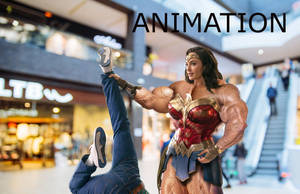Добавить любой RSS - источник (включая журнал LiveJournal) в свою ленту друзей вы можете на странице синдикации.
Исходная информация - http://search.deviantart.com/?q=boost%3Apopular+meta%3Aall+max_age%3A8h§ion=browse.
Данный дневник сформирован из открытого RSS-источника по адресу http://backend.deviantart.com/rss.xml?q=boost%3apopular+meta%3aall+max_age%3a8h, и дополняется в соответствии с дополнением данного источника. Он может не соответствовать содержимому оригинальной страницы. Трансляция создана автоматически по запросу читателей этой RSS ленты.
По всем вопросам о работе данного сервиса обращаться со страницы контактной информации.
[Обновить трансляцию]
Ascent |
I used Vue to render the entire landscape for this image. All objects were made by me. Daz Studio was used to create the female climber (Mei Lin - purchased character) which was inserted into the terrain as an 3D object. Lastly, Photoshop was used to insert the gas giant (my Saturn texture plus modifications) and its rings and moons. I also used two Solar System simulation programs to model how this scene should accurately appear given the suns angle, the tilt of the planet, and its rings. Without the simulations, it's hard to visualize how the ring shadows should realistically fall across the curved surface of the planet. But I can honestly say, this is accurate! If you like this scene, let me know what you think!

|
|
[gif] How To Draw Eyes |
twitter : twitter.com/fikaole
Instagram : instagram.com/fikaole
Feel free to follow if you interested.

https://www.deviantart.com/pikaole/art/gif-How-To-Draw-Eyes-857665714
|
|
[Render Anime] Yang Guifei (Fate) |
|
|
Monster Hunter - She's gonna eat me |

https://www.deviantart.com/isismasshiro/art/Monster-Hunter-She-s-gonna-eat-me-857664265
|
|
Scavenge |
.
.
.
.
.
.
.
.
.
For a new Artist like me this artwork took hours to be made, it can take you a matter of seconds to steal it; it should not be reproduced, copied and re-uploaded without my permission.
.
.
.
.
Find me on instagram/
Find me on facebook/

https://www.deviantart.com/nuhanotion/art/Scavenge-857663891
|
|
Kirin Flutters |
|
|
Leaf shape earrings |
Materials: resin, sliced shells, alloy parts
Size: Height of 6.2 cm x Wide of 3.3 cm x Depth 0.3 cm
*Not for sale

https://www.deviantart.com/nagispider/art/Leaf-shape-earrings-857663356
|
|
It's a trap!!! |
discord.gg/pG4VY4W
Pixiv:
www.pixiv.net/users/55759994

https://www.deviantart.com/eelusivemoon/art/It-s-a-trap-857663409
|
|
Boomerang heads - Diplocaulids |

https://www.deviantart.com/artbyjrc/art/Boomerang-heads-Diplocaulids-856073958
|
|
Adults crusaders |
18+ PSD dress-up www.patreon.com/posts/42589453
Gumroad gumroad.com/racoonkun
instagram www.instagram.com/racoonkun_ar…
tumblr www.tumblr.com/blog/racoonkun
pixiv www.pixiv.net/member.php?id=11…

https://www.deviantart.com/racoonkun/art/Adults-crusaders-857662946
|
|
Tools of the Trade |

https://www.deviantart.com/augustinasraginskis/art/Tools-of-the-Trade-857575967
|
|
Appledash Hercules |
Do not use. Do not repost
Applejack and Rainbow Dash are canon girlfriends. Here they are in their Nightmare Night couple costume. Disney's Hercules. I altered RD's costume to be a color better for her and made it shorter.

https://www.deviantart.com/cloudyglow/art/Appledash-Hercules-857572309
|
|
[SFM] [MLP] iPony |
Made an iPod Classic model from scratch just so that I could do this image lmao
Rendered at 4K @ 256 DoF samples
21 lights used in this scene
Models used:
- Sunset Shimmer (compiled from multiple models):
- ReVAmped anthro model pack: www.deviantart.com/aeridiccore… by AeridicCore
(also requires the V6 pony models): www.deviantart.com/aeridiccore…
- Hair: www.deviantart.com/empireoftim… by EmpireOfTime
- Tail: www.deviantart.com/aeridiccore… by AeridicCore
- Sweater: mega.nz/file/pE1VmIbb#gjmcZpqI… *
- Pants (tumblr link, NSFW warning): mrsmugbastard.tumblr.com/post/… **
- Boots: private model by me
* - The sweater model is made for the NexGen body. As such it is not optimized to fit on a ReVAmped model with ease.
** - Pants are edited to fit the unguligrade legs better.
- Apple iPod Classic: steamcommunity.com/sharedfiles… by me
- Headphones: steamcommunity.com/sharedfiles…

https://www.deviantart.com/imafutureguitarhero/art/SFM-MLP-iPony-857569455
|
|
MLP FIM 10 year anniversary |
Of course where ever you all live it's October 10th right now in mu home country while it's the 9rd in the Us, so I uploaded it a day ahead of the US.
I hope you will all like it.
The Mane 6 and Spike by FrownFactory
Starlight Glimmer, Sunset Shimmer, Flurry Heart by EmeraldBlast63
Applebloom and Scootaloo by jhayarr23
Sweetie Belle by AndoAnimalia
Trixie by IgokaPichka
lil Cheese and Big Sugar by MlpTmntDisneyKauane
Luster Dawn and Tempest Shadow by SketchMCreations
Background: pixnio.com/nature-landscapes/s…
My Little Pony belongs to Hasbro

https://www.deviantart.com/lachlancarr1996/art/MLP-FIM-10-year-anniversary-857568315
|
|
Zombies bite |
My OCs, Orange Princess got attacked by Pat the Undead and her fellow zombies.

https://www.deviantart.com/apetruk/art/Zombies-bite-857569689
|
|
Rainwiing :: Commission |
I may not respond to every comment, but i read and appreciate them all <3
 LINKS
LINKSTwitter :: Commission Info :: Ping List :: To Do List :: Review My Artwork :: Curious Cat

https://www.deviantart.com/lynx3000/art/Rainwiing-Commission-857535082
|
|
Headache Cured |
He wandered the City of Eldrian to free people from them, presenting his new invented spell without cost.
People called that murderer the Headhunter.
------------------------------------------------------------------------------------------
A.Shipwright
Artstation www.artstation.com/a_shipwrigh&
Twitter twitter.com/shipwrighta
Instagram www.instagram.com/a.shipwright

https://www.deviantart.com/ashpwright/art/Headache-Cured-857569058
|
|
Trouble at the Mall? Not on my watch! |
---
Once more a further collaboration with the ever wonderful jderril We hope you both enjoy it and please do check out the true 60fps 4k YouTube version including sound!
www.youtube.com/watch?v=Oumwy1…
Please to be leaving a comment with your thoughts feelings and a nice emoji to receive a prize! (there is no prize)

https://www.deviantart.com/aafsa/art/Trouble-at-the-Mall-Not-on-my-watch-857181984
|
|
Sweet Girls Photoshop Actions |
- The actions are for the best graphic designers and Photographers, with the only one 'play' click to the amazing colors, very easy for use, right organisation filters in one group, where you can adjust colors.
- Very observable results for all your photography, manipulations flyers and other creative artworks.
- Using these actions you will get on time and you will get beautiful colors with different effects
- Suitable for all photography.
- Can be used in several Photoshop versions.
This file contains:
- 4 Photoshop Actions - 1 ATN Files!
- Photoshop Actions- instructions.pdf

https://www.deviantart.com/viktorgjokaj/art/Sweet-Girls-Photoshop-Actions-857569074
|
|
Moon nuzlocke page 24 |
Undertow Nuzlocke Gallery Folder ll Ko-Fi ll Nuzlocke Forums ll Tumblr Ask blog ll Twitter
Riboo's Musings:
Apparently I'm a big dork and didn't do a musing write up for this because for some reason I skipped over it when I was uploading stuff on Patreon and scheduling. SO, I'ma do that now
Hope you guys have a good weekend!

https://www.deviantart.com/riboo/art/Moon-nuzlocke-page-24-857566637
|
|









